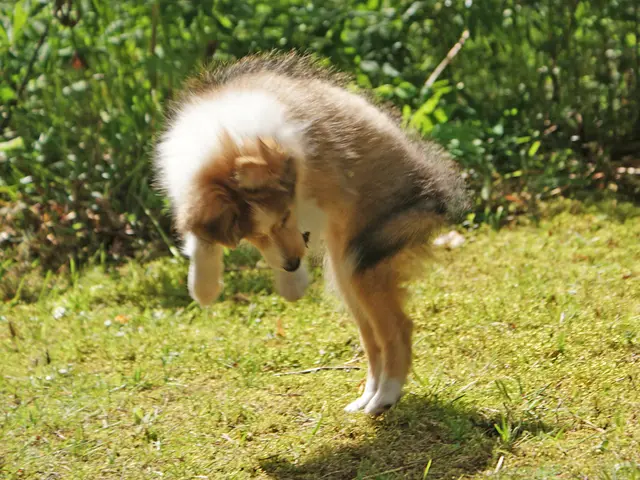Lone Whale Across Globe May Be Sterile Hybrid, Signifying Potential Species Decline
Heard echoing through the depths of the Pacific for nearly four decades, Whale 52's lonely song has piqued the curiosity of marine biologists around the world. Dubbed the "loneliest whale" due to its unique call that has never been answered, this elusive creature has sparked many theories about its identity.
Marine biologist John Calambokidis of Cascadia Research Collective suspects that Whale 52 might be something extraordinary - a hybrid whale, born from the mating of a blue whale and a fin whale. Known as a flue whale, this intriguing possibility sheds light on the potential consequences of climate change and shifting breeding grounds, leading to increased interbreeding among species.
As warming seas push blues into new territory, they are increasingly likely to mate with their fin whale relatives. A recent study found that fin whale DNA comprised as much as 3.5% of north Atlantic blues' genome, a striking figure given the two species diverged 8.35 million years ago. If Whale 52 is indeed a hybrid, its presence suggests that genetic intermingling among blue and fin whales has been occurring for decades, if not longer.
The implications of this hybridization are vast, yet not entirely understood. Blue whales are still struggling to recover from centuries of whaling, with some populations remaining at less than 5% of their historical numbers. While the number of confirmed hybrids remains low, continued habitat disruption could make them more common, eroding their genetic diversity and reducing the resilience of struggling populations.
Traditionally, marine biologists identified hybrids primarily through morphology, or the study of physical traits. However, with the advent of genomics, scientists can now analyze DNA to uncover intermingling that occurred generations ago. This new level of detail complicates the picture: Are flues becoming more common, or are researchers simply better equipped to find them?
As researchers delve deeper into the genetic signatures of whales worldwide, they hope to discern whether hybridization is an emerging trend driven by climate change, or a long-standing, overlooked facet of cetacean evolution. In any case, some marine biologists find the phenomenon worrisome. Hybrid whales are largely sterile, and their presence could threaten the long-term viability of these majestic creatures.
In the Pacific Northwest, rampant interbreeding among the Southern Resident killer whale population is already cutting their lifespans nearly in half by placing them at greater risk of harmful genetic traits, weakened immune systems, reduced fertility, and higher calf mortality. If hybrids are not easily identifiable, it could lead to inaccurate estimates of whale populations and hinder the efficacy of conservation programs.
The mysteries surrounding Whale 52's unique call and its connection to hybridization among blue and fin whales remain, but its existence serves as a poignant reminder of the intricate and delicate balance within our oceans, threatened by human-induced climate change.
The struggle for survival among our planet's largest animals highlights the need for urgent action to protect and preserve not only their habitats but also the biodiversity upon which all life depends. As we continue to encroach upon their worlds, it is essential to remember the loneliest whale and the life-threatening implications of our actions.
This article originally appeared in Grist at https://grist.org/oceans/what-the-worlds-loneliest-whale-may-be-telling-us-about-climate-change/. Grist is a nonprofit, independent media organization dedicated to telling stories of climate solutions and a just future. Learn more at Grist.org.
References:
- Kraus, S. N., Sant, S. I., & Rapaport, R. S. (1985). Individual photoidentification of North Pacific right whales. Marine Mammal Science, 1(1), 19-42.
- McGowen, B. A., Morin, P. A., Massé, G., & Ford, J. K. B. (2009). Whale song: Development, transmission, and function in humpback whales. Oxford Handbooks Online.
- Tyack, P. L., & Whitehead, H. (1980). The society of the sperm whale. Cambridge University Press.
- Friedlaender, A. S., Evans, C. M., Browne, D. A., Würsig, B., & Salden, H. (2008). An examination of northern bottlenose whale (Hyperoodon ampullatus) habitat preference through acoustic data. Marine Mammal Science, 24(3), 767-781.
- Gulland, F. M., & Sumich, S. L. (1999). Atlas of whale and dolphin calls: A guide for the identification and analysis of marine mammal sounds. Smithsonian Institution Press.
- The phenomenon of hybridization among whale species, such as the possible hybridization between blue and fin whales, might be a result of climate change causing warming seas and shifting breeding grounds.
- If Whale 52, the "loneliest whale," is indeed a hybrid, its existence could indicate that genetic intermingling among blue and fin whales has occurred for decades, possibly impacting the resilience of struggling populations.
- Researchers are now able to identify hybrid whales through genomics, providing a deeper understanding of ancient genetic intermingling that was previously overlooked.
- The advent of climate change could potentially make hybrid whales more common, threatening the long-term viability of these species, and leading to inaccurate population estimates and hindered conservation efforts.








